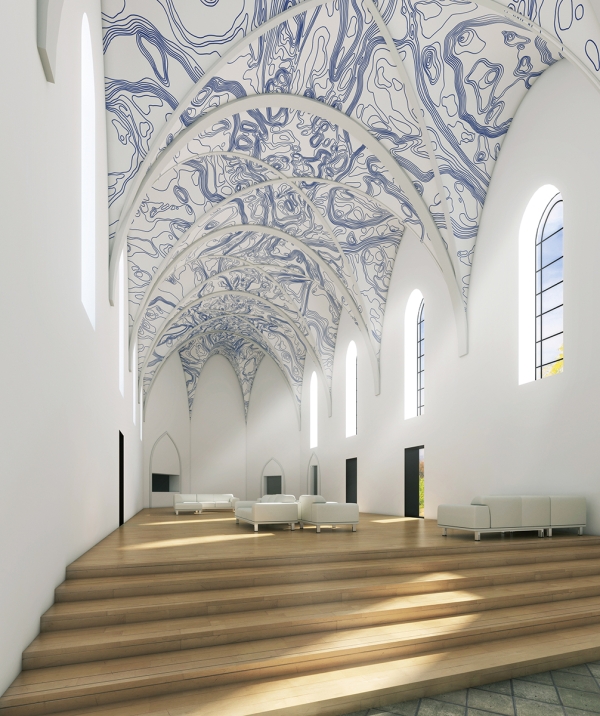BOLBEMIT
Toegevoegd op 19 januari 2015 door sne

Afbeelding toegevoegd door sne
Kunstenaar:
Nick Ervinck
Nick Ervinck
Opschrift:
BOLBEMIT, 2013-2014
200m²
BOLBEMIT, 2013-2014
200m²
Plaatsbeschrijving:
Hasselt - WZC Clarenhof
Hasselt - WZC Clarenhof
The rib vault of the Clarenhof Chapel in Hasselt seems to be covered with Dutch Delft tiles, popular blue painted pottery made in and around Delt (the Netherlands) in the 16th century. In reality this ceiling is the result of the creative interplay between the digital design and the meticulously painting.
The design is spread out on the ceiling as a spider web and has its basis in a series of digital designed ‘blob sculptures’: computer generated forms that question the rigidity and immobility of the architectural stucture. This tension between blobs and boxes is a recurring theme in the work of Nick Ervinck and is reflected by applying different copy-paste techniques of 3D technology in sculpture.
These forms are however not permanently situated in the virtual space but were turned back in a graphic abstraction. The result is a dynamic line drawing that refers to the traditional graphic techniques, but also to contemporary grafitti, street art and digital design. In his work Ervinck therefore questions the compatiblity between the virtual and actual space and focuses on the in situ relationship between sculpture and architecture.
Painting the ceilings of churches has a long history. While artists during the Middle Ages applied biblical scenes in seperate compartments, painters in the Renaissance and Baroque wanted to ‘open up’ the ceiling by displaying clouds scenes and floating putti (think of Michelangelo’s Sistine Chapel and the dazzling frescoes from Andrea Pozzo).
By means of such illusionism these painters ‘discovered’ heaven and brought it withing reach. Although Ervinck doesn’t apply putti and clouds scenes on the ceiling tof the Clarenhof Chapel, he seems to proclaim heaven as its limit: not only in his pursuit of pushing the limits of technology but also symbolic. The drawing shows indeed similarities with an organic ivy structure that seems to ‘grow’. In addition, the graphic lines recall the contours of a hiking map or a topographic map. In other words, the outside world is brought inside.
The rib vault of the Clarenhof Chapel in Hasselt seems to be covered with Dutch Delft tiles, popular blue painted pottery made in and around Delt (the Netherlands) in the 16th century. In reality this ceiling is the result of the creative interplay between the digital design and the meticulously painting.
The design is spread out on the ceiling as a spider web and has its basis in a series of digital designed ‘blob sculptures’: computer generated forms that question the rigidity and immobility of the architectural stucture. This tension between blobs and boxes is a recurring theme in the work of Nick Ervinck and is reflected by applying different copy-paste techniques of 3D technology in sculpture.These forms are however not permanently situated in the virtual space but were turned back in a graphic abstraction. The result is a dynamic line drawing that refers to the traditional graphic techniques, but also to contemporary grafitti, street art and digital design. In his work Ervinck therefore questions the compatiblity between the virtual and actual space and focuses on the in situ relationship between sculpture and architecture.
Painting the ceilings of churches has a long history. While artists during the Middle Ages applied biblical scenes in seperate compartments, painters in the Renaissance and Baroque wanted to ‘open up’ the ceiling by displaying clouds scenes and floating putti (think of Michelangelo’s Sistine Chapel and the dazzling frescoes from Andrea Pozzo).By means of such illusionism these painters ‘discovered’ heaven and brought it withing reach. Although Ervinck doesn’t apply putti and clouds scenes on the ceiling tof the Clarenhof Chapel, he seems to proclaim heaven as its limit: not only in his pursuit of pushing the limits of technology but also symbolic. The drawing shows indeed similarities with an organic ivy structure that seems to ‘grow’. In addition, the graphic lines recall the contours of a hiking map or a topographic map. In other words, the outside world is brought inside.
The design is spread out on the ceiling as a spider web and has its basis in a series of digital designed ‘blob sculptures’: computer generated forms that question the rigidity and immobility of the architectural stucture. This tension between blobs and boxes is a recurring theme in the work of Nick Ervinck and is reflected by applying different copy-paste techniques of 3D technology in sculpture.These forms are however not permanently situated in the virtual space but were turned back in a graphic abstraction. The result is a dynamic line drawing that refers to the traditional graphic techniques, but also to contemporary grafitti, street art and digital design. In his work Ervinck therefore questions the compatiblity between the virtual and actual space and focuses on the in situ relationship between sculpture and architecture.
Painting the ceilings of churches has a long history. While artists during the Middle Ages applied biblical scenes in seperate compartments, painters in the Renaissance and Baroque wanted to ‘open up’ the ceiling by displaying clouds scenes and floating putti (think of Michelangelo’s Sistine Chapel and the dazzling frescoes from Andrea Pozzo).By means of such illusionism these painters ‘discovered’ heaven and brought it withing reach. Although Ervinck doesn’t apply putti and clouds scenes on the ceiling tof the Clarenhof Chapel, he seems to proclaim heaven as its limit: not only in his pursuit of pushing the limits of technology but also symbolic. The drawing shows indeed similarities with an organic ivy structure that seems to ‘grow’. In addition, the graphic lines recall the contours of a hiking map or a topographic map. In other words, the outside world is brought inside.
